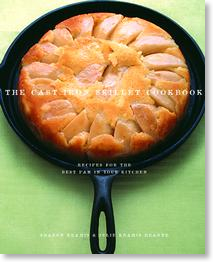Cajun Smoked Sausage and Andouille in Brown Gravy

One of the items I buy when in Louisiana is real andouille sausage. I’ll use it in my recipes until I run out. Then I have to use that Yankee brand (Johnsonville) until we can make another run south.
Coming back stocked up on good sausage made me sort through my old copies of Louisiana Cookin’ Magazine for the recipe that is in this post. This particular recipe is adapted from a 19th century dish. I’m pretty sure I have the older one and have made it before, but for the moment, I cannot put my finger on it. I’ve made this recipe or some form of it about three times now. Slow-cooking the sausage in a dutch oven results in very tender meat that falls apart in your mouth. Kathy is not normally much for sausage as a main ingredient; it’s fine for her in something like red beans and rice. But this is a recipe that she really enjoys, as do I.
Often with recipes that use andouille or smoked sausage, a skillet is used in combination with the main pot. One convenient aspect of this recipe is that everything can be prepared in one pot. For this recipe, I used Savoie’s andouille and Down Home medium smoked sausage (if you know of a link for the latter, contact me).
The original recipe said that this made four servings. Okay, I know some people are prone to overeating, but a person would have to have really large bowls to spread this out over only four servings. Eight or more servings is more realistic--even for hearty eaters.
CAST IRON REQUIRED:
- Dutch Oven (Lodge 5 quart pictured here)
INGREDIENTS:
- 1 pound andouille
- 6 cups water, in all
- 1 pound Cajun smoked pork sausage
- 2 tablespoons vegetable oil
- 3 cups cooked long grain white rice
- salt, to taste
- black pepper, to taste
- cayenne pepper, to taste
DIRECTIONS:
Boil the andouille in 3 cups of the water until tender, about 30 minutes. Drain, discard the water and set the andouille aside to cool.
Cut the Cajun smoked pork sausage into bite-sized pieces. Quarter the andouille lengthwise and cut into bite-sized pieces.
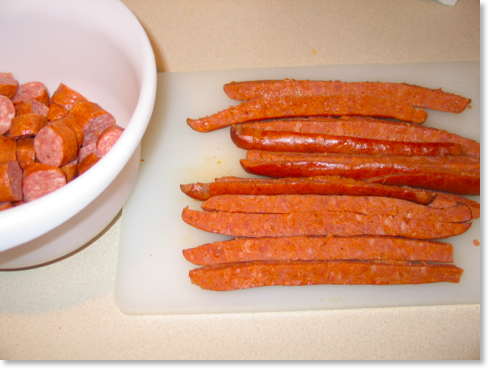
Heat the oil in a cast iron pot over a medium high heat. Add the sausage and andouille and sauté until well-browned, about 5 to 7 minutes.
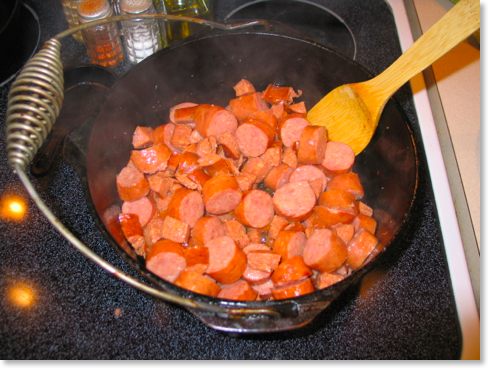
Add one cup of water to deglaze the bottom of the pot, scraping it with a wooden spoon. Add the remaining water and bring to a boil.
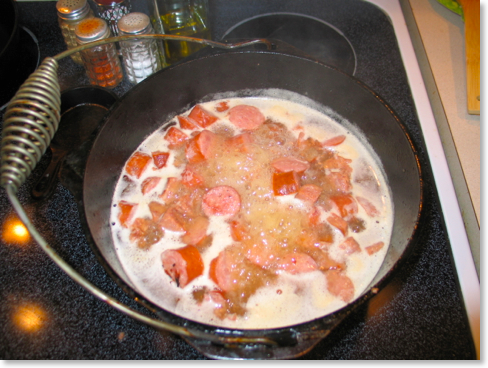
Cover, reduce the heat to low, and simmer, stirring occasionally, for 2 1/2 hours.
After two hours, taste and adjust with salt, black pepper and cayenne, if necessary (it wasn’t necessary this time due to the spice already in the sausages).
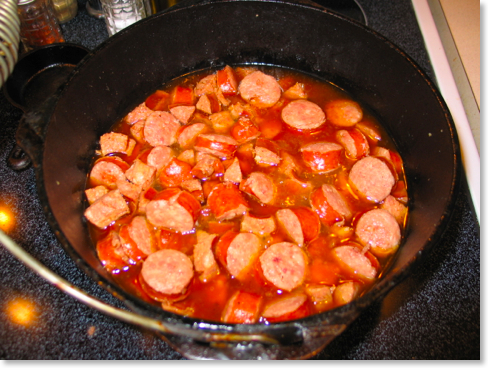
Serve over white rice.
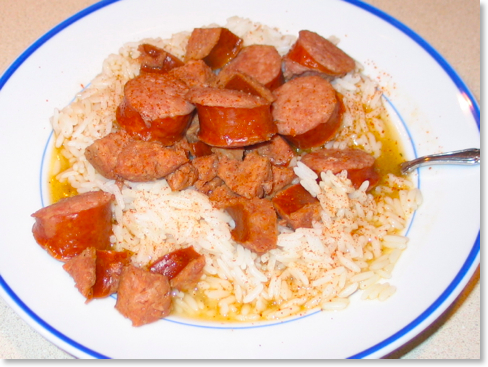
As I mentioned, I’ve made different variations of this recipe before. One of these other methods required slow cooking the dish in the oven instead of on the stovetop. I’ve had results with thicker gravy, although there’s nothing to complain about the outcome shown above. The gravy in this case was more like a broth, but a very rich one made from the juices of the sausages mixed with the water. Adding less water would result in a thicker gravy if desired.
This recipe originally appeared in the February, 2002, issue of Louisiana Cookin’ Magazine.
Feel free to leave your thoughts or ask questions in the comments below, or you can contact Rick directly at rick@cookingincastiron.com.
Review: The Cast Iron Skillet Cookbook (Part 1)
The Cast Iron Skillet Cookbook: Recipes for the Best Pan in Your Kitchen
By Sharon Kramis & Julie Kramis Hearne
2004, Sasquatch Books. ISBN 1570614253
Our household is not only filled with cast iron cookware, but also with a variety of cookbooks specifically aimed at aspiring cast iron chefs. This multi-part review will cover my experiments with six of the recipes from The Cast Iron Skillet Cookbook: Recipes for the Best Pan in Your Kitchen. The book was published in 2004 by Sasquatch Books, and it features six categories of recipes: “Breakfast & Brunch,” “Appetizers,” “Entrées,” “Sides,” “Outdoor Cookery,” and “Desserts.”
The authors, a mother/daughter duo, penned a terrific introduction that tells the history of cast iron cooking through four generations of their family, making for interesting reading. A section on how to care for cast iron is an added bonus that will serve cast iron newbies well.
Recipe #1: Monday Night Meatloaf (Entrées, p. 47)
Cast Iron Required:
• 10.25” or 12” skillet
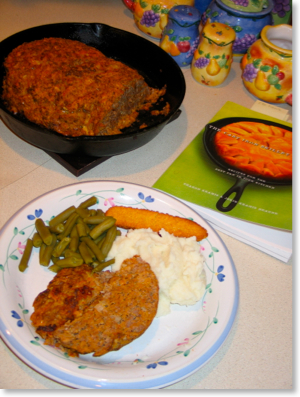
What I liked about the recipe:
- Simple ingredient list
- Very little prep work
- Pork combined with beef
- No bell peppers
What I didn’t like about the recipe:
- No glaze
- Ketchup suggested for dipping
Ingredients:
- 2 tablespoons salted butter
- 1 cup chopped yellow onion (about 1 medium-sized onion)
- 1 cup fresh bread crumbs
- 1 pound extra-lean ground beef
- 1/2 pound ground pork
- 1 can (8 ounces) tomato sauce
- 2 large eggs
- 1 cup grated cheddar cheese
- 1 teaspoon salt
- 1/2 teaspoon freshly ground black pepper
- 2 teaspoons dried Italian herb seasoning
- Ketchup, for serving
Directions:
Position a rack in the center of the oven and preheat to 350°
In a 10- or 12-inch cast iron skillet, melt the butter over medium heat. Stir in the chopped onion and cook for 3 minutes.

Transfer to a large mixing bowl. Place all of the remaining ingredients in the bowl with the onions, and mix together with your hands until well blended.

Form into a football-shaped loaf in the same skillet in which you cooked the onions.

Place the skillet in the oven and bake until the center is no longer pink, about 1 hour. Let cool for 10 minutes.

Pour off the excess fat and juices. Slice and serve hot, with ketchup for dipping [we opted not to use Ketchup, although Rick used Country Bob’s on his second helping].![]() MacGourmet users, click image to download recipe (or simply drag image to your MacGourmet recipe box).
MacGourmet users, click image to download recipe (or simply drag image to your MacGourmet recipe box).
Recipe #2: Horseradish Mashed Potatoes (“Entrées,” p. 51)
This recipe, although listed in the cookbook, is not a featured dish. It is listed as an “accompaniment” to the “Braised Spareribs in Merlot Sauce” (p. 50-51) I plan to make that dish for a later review, but I wanted some sort of mashed potato side for the meatloaf, so I chose to use it this time, too. It does not use cast iron cookware, however.
Ingredients:
- 2 pounds russet or Yukon Gold potatoes, peeled and quartered
- 1/2 teaspoon salt, plus more for seasoning
- 6 tablespoons heavy cream or half-and-half3 tablespoons unsalted butter
- 3 tablespoons mascarpone or sour cream
- 1 tablespoon creamy horseradish
- Freshly ground black pepper
Directions:
Place the potatoes in a large stockpot with the 1/2 teaspoon salt and enough water to cover.
Bring to a rapid boil over high heat. Reduce the heat to medium and cook until soft: drain. Return the potatoes to the pot and cook over medium heat for 3 to 5 minutes, allowing them to absorb some of the moisture. Reduce the heat to low and shake the potatoes over the heat for 3 minutes. Mash with a potato ricer, using medium-wide holes.
In a small saucepan over low heat, mix together the cream, butter, mascarpone, and horseradish. Cook for 5 minutes. Be careful not to let this mixture come to a boil.
Slowly pour the cream mixture into the potatoes while whipping the potatoes with a fork or a whisk. Mix until light and fluffy. Season to taste with salt and pepper and serve hot.
Final Results:

Wow! This meatloaf is definitely a keeper! And, although Rick was wary of the horseradish potatoes, he was pleasantly surprised. I look forward to trying more dishes during the next few weeks. Look for reviews of “Braised Spareribs in Merlot Sauce,” “Slow-Roasted Beef Brisket with Apple Cider-Ginger Barbecue Sauce and Caramelized Sweet Onions,” “Herbed Skillet Bread,” and “Brown Sugar Coffee Cake.” I can’t wait!
You can also follow one of The Cast Iron Skillet’s co-writers, Julie Kramis Hearne on her website, blog and on Twitter.
Feel free to leave your thoughts in the comments below, or you can contact Kathy directly at kathy@cookingincastiron.com.
Follow Us on Twitter
I’ve been sending out tweets about new posts here on Cooking in Cast Iron for a while through my personal Twitter account. But I think that’s been confusing for some folks, so I’m setting up a distinct Twitter account for this site. We will primarily use this Twitter account to announce new posts and perhaps occasionally news related to cooking in cast iron.
By the way, our Twitter account can be found at http://www.twitter.com/cookingcastiron. Yes, we left out a word. But Twitter limits user names to 15 characters and “cookingINcastiron” is 17 characters.
So, I hope you’ll follow us on Twitter. We’ll keep you up to date with what’s going on with Cooking in Cast Iron!
My Favorite Gumbo

Although I grew up in Louisiana, I never had gumbo until I was about eleven or twelve years old because I was from north Louisiana. Back then the cultures of north and south Louisiana were as different as daylight and dark. When most people outside Louisiana think of the state, they are thinking of south Louisiana. But where I grew up, we probably had more in common with folks from Mississippi, Arkansas, and east Texas.
The cultures of north and south Louisiana are still distinct, but the Cajun and Creole cultures of the south are winning out, especially when it comes to food. It’s nothing today to see signs for crawfish for sale all around north Louisiana and little restaurants with names like “Cajun Cafe.” And who can complain since it’s really good stuff?

This past week while we visited family in Louisiana, it was hot! One day it reached 100° and gumbo was the furthest thing from our mind. Then however it rained the last three or four days we were there. With the cooler temperatures upon us, I grabbed my Lodge 5 quart dutch oven
I’ve made many different gumbo recipes over the years, but this one is my all time favorite. There are all kinds of gumbos, and in spite of the fact that gumbo is an African word for okra, the recipe below does not contain any (although you could easily add it). This is also a Cajun (brown) gumbo as opposed to a Creole (red, tomato-based) gumbo. It is not a seafood gumbo, but rather, is called Chicken Sausage Filé Gumbo. Filé is a powder made from ground sassafras leaves. It is added to a serving of gumbo once it is already in the bowl to thicken it.
This particular recipe comes from a book given to me by my mother-in-law fifteen years ago. It’s called Cajun Men Cook
If you’ve ever come over to my house for gumbo, this is probably the recipe I used. One thing you’ll note if you pick up Cajun Men Cook is that many parts of what you see below is different from what’s in the book. Over the years, I’ve tweaked and adapted the recipe quite a bit.
Chicken Sausage Filé Gumbo
Cast Iron Required
- 7 Quart Dutch
- Cast Iron Skillet
- 1 cup medium brown roux
- 1 three lb. chicken, boiled in 2 1/2 quarts of water and deboned (save stock for gumbo).
- 1 lb. andouille or smoked sausage, cut in 1/2 inch slices
- 2 tablespoons water
- 2 tablespoons oil
- 2 celery ribs, chopped
- 4 cloves garlic, minced
- 2 medium onions, chopped
- 1/4 cup fresh parsley, chopped
- 1/4 cup green onions, minced
- 1 teaspoon Worcestershire sauce
- 3 tablespoons browning sauce
- 2 teaspoons corn starch
- salt and red pepper to taste
- filé powder.
Note: I always make this gumbo in a cast iron. A seven quart Dutch oven is probably the best choice, although it will fit in the five quart, leaving only about one inch of room at the top. If you make a double batch, I recommend a nine quart Dutch oven. The Dutch oven in these pictures is a five quart because that’s all that I had with me at the time.
“First, you make a roux.” This recipe like many Cajun dishes assume that you know how to make a roux already. A roux is really nothing more than flour that’s been allowed to cook so long that it begins to turn brown. Technically, it’s burning, but you want to be careful that it doesn’t burn too much. You’re also going to burn your wooden spoon, so just get over that. I don’t recommend using anything plastic to make a roux, but a silicone spatula would be up to it.

There are numerous methods for making a roux, but what I did for this recipe was to combine 3/4 cup of flour with 3/4 cup Wesson oil to equal roughly one cup of finished roux. Note that I did not measure out an exact cup afterwards. The roux cooked in the pot never left it. Also, if you’re planning for guests and making a roux from scratch add about 45 minutes to an hour to your cooking time. And keep stirring no matter what!
After the roux reaches a nice chocolate brown color, slowly stir in two quarts of broth.
Add vegetables except green onions, parsley, and garlic and bring to a boil for 5 minutes. You may want to use a whisk to blend roux with stock. Stir until everything is well blended, and be careful that the roux does not sink to the bottom of the pot and stick.

In a cast iron skillet, fry andouille sausage with water and oil, allowing water to evaporate before frying begins [skip this step if the sausage is already cooked].

When sausage is light brown put into stock pot. Put chopped up chicken, garlic, and seasonings except pepper. Cover and simmer for one hour.

I tend to come back to the pot and stir the gumbo every 15 minutes or so. The gumbo should be simmering, but not at a full boil. As always, make sure that nothing is sticking at the bottom of the pot.

Add pepper, parsley, green onions, Worcestershire sauce, browning sauce and resalt as needed to adjust taste. Dissolve corn starch in 2 tablespoons of water; stir into gumbo. Simmer 5 minutes and then turn off fire and keep covered. If necessary, skim off excess oil.



Serve over fluffy long grain rice as a soup (I prefer Zatarrain’s Enriched Long Grain Parboiled Rice for any gumbo or étouffée because when prepared correctly, it will not get mushy).
Add filé to each individual serving of gumbo. Do not cook in gumbo as it will make soup stringy.
You’ll have to pardon the fact that the bowls said “seafood gumbo.” They seemed appropriate nonetheless, and our chicken sausage filé gumbo was just as good anyway.

Alternate Method #1: To save time, I have bought rotisserie chickens and use the meat pulled from them. Then you can use two quarts of store-bought chicken stock.
Alternate Method #2: To not only save time, but also for a healthier version of this gumbo, I’ve made it with Tony Chachere’s Instant Roux Mix on a number of occasions. It won’t be as good as a real roux, but it’s still good and a smart option if you’re craving gumbo but watching your weight. If you decide to go this route, stir together one cup of the roux mix and two cups of the chicken stock. Slowly add the mixture to the rest of the stock and vegetables after they have already started boiling. This will require a good bit of stirring with a whisk to make sure the instant roux fully blends with the broth.
Feel free to leave your thoughts or ask questions in the comments below, or you can contact Rick directly at rick@cookingincastiron.com.
Experimenting with Scallops

The vast majority of my experience with scallops comes from eating them, not cooking them. I’ve also noticed that scallops are often the foil on Gordan Ramsay’s Hell’s Kitchen as he screams at the competing chefs that the scallops are either raw (undercooked) or like rubber (overcooked) before hurling them against the wall. So, in light of the fact that I do like scallops quite a bit, and because I took Ramsay’s rants on television as a bit of a personal challenge, I decided I would see if I could cook them myself.
I scanned the internet for methods as well as asking for input on the Castiron Cookware discussion list. I wanted to start out as basic as possible knowing that I can later expand from there. After reading as much as I thought was necessary, I settled on a very basic method.
First, I decided upon using a skillet a bit larger than my normal 10 1/4” that serves as my primary cast iron instrument. Having read that scallops need to have room when they cook, I chose a Lodge Pro Logic 12" skillet
The only daunting aspect to the scallops was the price. Keep in mind that we now live in Kentucky, so sea scallops are not a native resource. They have to be shipped in. Although I’ve now found a slightly less expensive source for scallops, the ones you are looking at in the picture above cost more than a dollar each!
As I mentioned, I chose a very basic method for cooking the sea scallops. I heated a couple of tablespoons of olive oil in the 12” skillet. Then I cooked the scallops about two minutes each side, lightly sprinkling them with salt and pepper. When cooked properly, the scallops will have a light golden brown color to them. The finely manicured hand in the photo above is not mine, but Kathy’s as I took the picture; but you can see the eight that have been turned and the four remaining to be turned.
On the night that I experimented with scallops, we had brave guests over for dinner who sampled them with me. I chose to make the scallops an appetizer rather than the main dish not only because of their price, but also due to the fact that I was experimenting with them. Nevertheless, they came out perfect which makes me really wonder about the competence of those competing on Hell’s Kitchen. I mean, I really cannot overemphasize how easy these were to prepare.
With the scallops, I simply provided two dishes of melted butter and garlic for dipping, one of which had a few drops of Habanero Tabasco. Everyone thought the scallops were great, even Kathy who rarely strays from steak, burgers, or catfish.
Now that I’ve successfully cooked the scallops with the most basic of methods, I can begin experimenting with new recipes. What about you? How do you prepare scallops? Do you have a favorite recipe? Please share your thoughts in the comments below.
Feel free to leave your thoughts or ask questions in the comments below, or you can contact Rick directly at rick@cookingincastiron.com.






